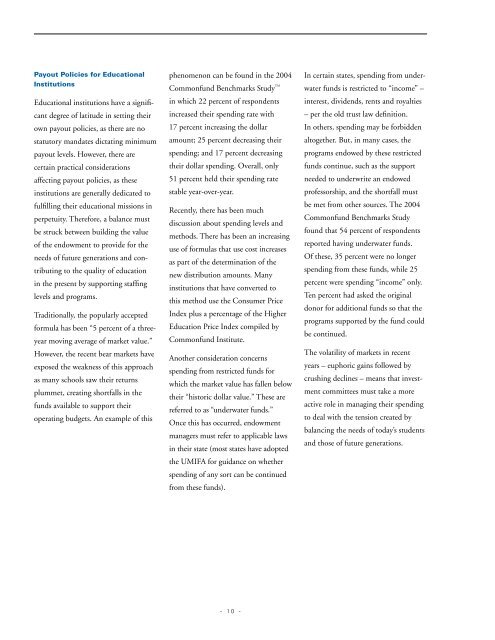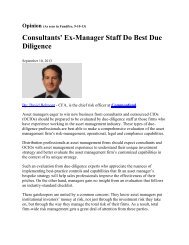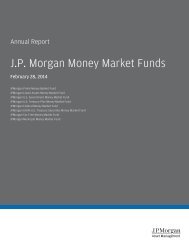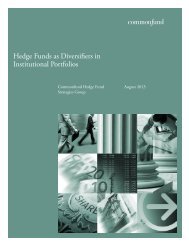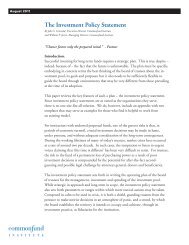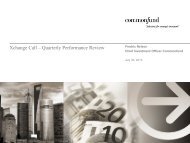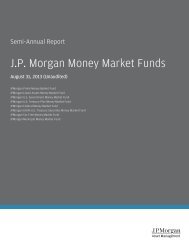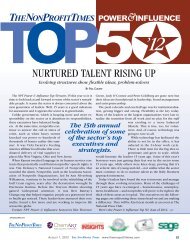Principles of Nonprofit Investment Management - Commonfund
Principles of Nonprofit Investment Management - Commonfund
Principles of Nonprofit Investment Management - Commonfund
Create successful ePaper yourself
Turn your PDF publications into a flip-book with our unique Google optimized e-Paper software.
Payout Policies for EducationalInstitutionsEducational institutions have a significantdegree <strong>of</strong> latitude in setting theirown payout policies, as there are nostatutory mandates dictating minimumpayout levels. However, there arecertain practical considerationsaffecting payout policies, as theseinstitutions are generally dedicated t<strong>of</strong>ulfilling their educational missions inperpetuity. Therefore, a balance mustbe struck between building the value<strong>of</strong> the endowment to provide for theneeds <strong>of</strong> future generations and contributingto the quality <strong>of</strong> educationin the present by supporting staffinglevels and programs.Traditionally, the popularly acceptedformula has been “5 percent <strong>of</strong> a threeyearmoving average <strong>of</strong> market value.”However, the recent bear markets haveexposed the weakness <strong>of</strong> this approachas many schools saw their returnsplummet, creating shortfalls in thefunds available to support theiroperating budgets. An example <strong>of</strong> thisphenomenon can be found in the 2004<strong>Commonfund</strong> Benchmarks Study TMin which 22 percent <strong>of</strong> respondentsincreased their spending rate with17 percent increasing the dollaramount; 25 percent decreasing theirspending; and 17 percent decreasingtheir dollar spending. Overall, only51 percent held their spending ratestable year-over-year.Recently, there has been muchdiscussion about spending levels andmethods. There has been an increasinguse <strong>of</strong> formulas that use cost increasesas part <strong>of</strong> the determination <strong>of</strong> thenew distribution amounts. Manyinstitutions that have converted tothis method use the Consumer PriceIndex plus a percentage <strong>of</strong> the HigherEducation Price Index compiled by<strong>Commonfund</strong> Institute.Another consideration concernsspending from restricted funds forwhich the market value has fallen belowtheir “historic dollar value.” These arereferred to as “underwater funds.”Once this has occurred, endowmentmanagers must refer to applicable lawsin their state (most states have adoptedthe UMIFA for guidance on whetherspending <strong>of</strong> any sort can be continuedfrom these funds).In certain states, spending from underwaterfunds is restricted to “income” –interest, dividends, rents and royalties– per the old trust law definition.In others, spending may be forbiddenaltogether. But, in many cases, theprograms endowed by these restrictedfunds continue, such as the supportneeded to underwrite an endowedpr<strong>of</strong>essorship, and the shortfall mustbe met from other sources. The 2004<strong>Commonfund</strong> Benchmarks Studyfound that 54 percent <strong>of</strong> respondentsreported having underwater funds.Of these, 35 percent were no longerspending from these funds, while 25percent were spending “income” only.Ten percent had asked the originaldonor for additional funds so that theprograms supported by the fund couldbe continued.The volatility <strong>of</strong> markets in recentyears – euphoric gains followed bycrushing declines – means that investmentcommittees must take a moreactive role in managing their spendingto deal with the tension created bybalancing the needs <strong>of</strong> today’s studentsand those <strong>of</strong> future generations.- 10 -


